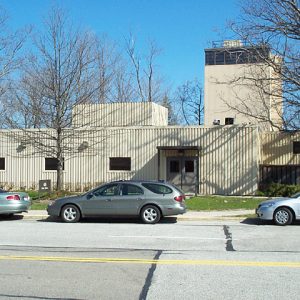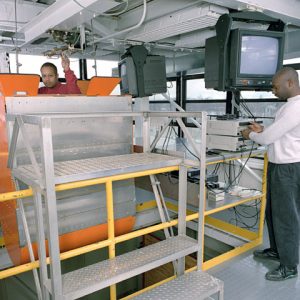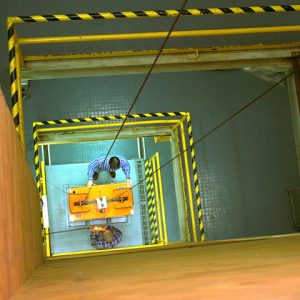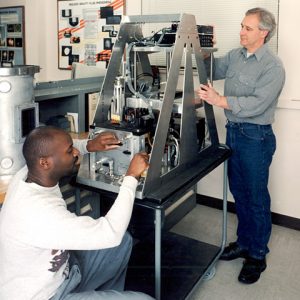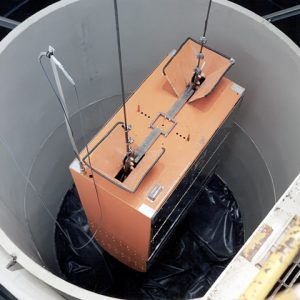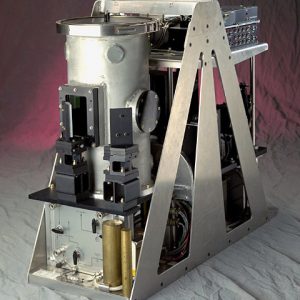2.2 Second Drop Tower
The 2.2 Second Drop Tower has been used for nearly 50 years by researchers from around the world to study the effects of microgravity on physical phenomena such as combustion and fluid dynamics and to develop technology for future space missions.
Facility Overview
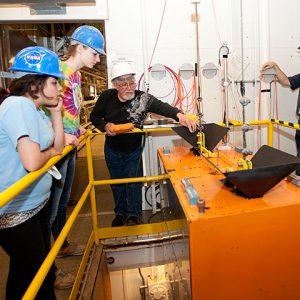
The NASA Glenn 2.2 Second Drop Tower is one of two drop towers located at the NASA site in Brook Park, Ohio. The tower, which began life as a 100-foot high fuel distillation tower, dangles over a bluff at the Glenn Research Center. The tower has been used forover 50 years by researchers from around the world to study the effects of microgravity on physical phenomena such as combustion and fluid dynamics, and to develop new technology for future space missions.
Microgravity, which is the condition of apparent (near) weightlessness, can only be achieved on or near Earth by putting an object in a state of free fall. In this way, NASA conducts microgravity experiments on Earth using drop towers and aircraft flying parabolic maneuvers, and in space using unmanned rockets, and the International Space Station.
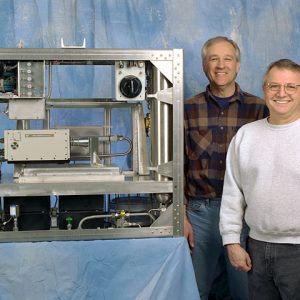
The 2.2 Second Drop Tower is “a gateway to space” for many of the microgravity experiments conducted on the International Space Station because these experiments often begin on Earth with exploratory testing in the drop tower. This may be followed by further drop testing to verify or optimize the design of the space hardware and to identify the best test conditions for the space experiment. As such, the drop tower is used to maximize the scientific return from experiments conducted in space. This is an important role, given the significant investment required to conduct space experiments in both time and money.
The drop tower’s 2.2 second microgravity test time is created by allowing the experiment package to free fall a distance of 79 feet (24 m). The Drop Tower uses an experiment/drag shield system to minimize the aerodynamic drag on the free falling experiment. Experiments are assembled in a rectangular aluminum frame which is enclosed in an aerodynamically designed drag shield (which weighs 725 pounds, 330 kg). This package is hoisted to the top of the tower (the eighth floor), where it is connected to monitoring equipment (e.g., high-speed video cameras and on-board computers) before being dropped. A low gravity environment is created as the package freefalls from the eighth floor to the first floor, a distance of 79 feet 1 inch (24 m). The experiment is isolated from aerodynamic drag because it is not attached to the drag shield. The experiment itself falls seven and one half inches (19 cm) within the drag shield while the entire package is falling. The drop ends when the drag shield and experiment are stopped by an airbag, located at the bottom of the tower.
Quick Facts
The drop tower’s 2.2 second microgravity test time is created by allowing the experiment package to free fall a distance of 79 feet (24 m). The Drop Tower uses an experiment/drag shield system to minimize the aerodynamic drag on the free falling experiment. Experiments are assembled in a rectangular aluminum frame which is enclosed in an aerodynamically designed drag shield (which weighs 725 pounds, 330 kg). This package is hoisted to the top of the tower (the eighth floor), where it is connected to monitoring equipment (e.g., high-speed video cameras and on-board computers) before being dropped.
| Operational Parameters | |
|---|---|
| Microgravity Duration | 2.2 seconds |
| Free Fall Distance | 79 feet, 1 inch (24 m) |
| Gravitational Acceleration | 0.001 g |
| Mean Deceleration | 15 g |
| Peak Deceleration | 30 g |
| Experimental Drop Packages | |
| Gross Drop Package Weight | 1075 lbs. (487 kg) (drag shield and equipment) |
| Experimental Payload Weight | up to 350 lbs. (159 kg) |
| Experimental Payload Diameter | 38 inches wide, 33 inches high, 16 inches deep (96cm x 84cm x 40cm) |
- Microgravity experiments are often tested in the drop tower before use on the International Space Station.
- A low gravity environment is created as the package freefalls from the eighth floor to the first floor. The drop ends when the drag shield and experiment are stopped by an airbag, located at the bottom of the tower.
- The drop tower’s 2.2 seconds microgravity test time is created by allowing the experiment package to free fall a distance of 79 feet (24m).
Capabilities
Operational Parameters
- Microgravity Duration: 2.2 seconds
- Free Fall Distance: 79 feet (24 m)
- Gravitational Acceleration: <0.001 g
- Mean Deceleration: 15 g
- Peak Deceleration: 30 g
Experimental Drop Package
- Payload Width: 38 in. (96 cm)
- Payload Height: 33 in. (84 cm)
- Payload Depth: 16 in. (40 cm)
- Payload weight: up to 350 lbs (159 kg)
- Gross vehicle weight: 1075 lbs. (487 kg)
Instrumentation/Data Acquisition
- Digital and Analog Video Cameras
- Analog-Digital Data Acquisition, 32 channels
- 24 VDC Battery Power
- Programmable Logic Controller
- Pressure Transducers
- Flow Meters
- Thermocouples
- Radiometers
- Lasers
Mode of Operation
- Provides microgravity test environment for a fraction of the cost of conducting an experiment in space, lowest cost of all NASA ground based microgravity facilities
- Can accommodate NASA, government, and private industry research programs
- Twelve drops per day
- Engineering staff to perform or consult on payload design
- Experimenter can integrate experiment hardware into NASA provided experiment frame or facility technical staff can perform electrical and mechanical integration of payloads
- Third party safety review of experiments is required
Contact
2.2 Second Drop Tower
Facility Manager: Thomas Hoffman
216-433-5637
thomas.r.hoffman@nasa.gov
Test Facility Management Branch
Branch Chief: Michael S. McVetta
216-433-2832
michael.s.mcvetta@nasa.gov
Using Our Facilities
NASA’s Glenn Research Center provides ground test facilities to industry, government, and academia. If you are considering testing in one of our facilities or would like further information about a specific facility or capability, please let us know.
Did you test in one of our facilities? Let us know about your experience by participating in our customer facility evaluation survey.

